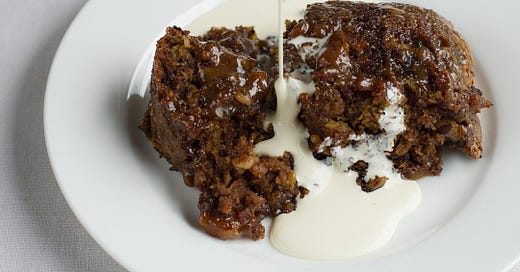Once in a while a long time ago when I was young, rough and in possession of coarse Devon ways I would occasionally be asked if I wanted a snog. Now that I’m old, rough and in possession of coarse Devon ways that question has been replaced with ‘What can I do with medlars other than make medlar jelly?’
Those that ask have, at least these days, come to the right person.
You might not be familiar with medlars. I discovered them by accident 20 odd years ago: flipping through my just-arrived copy of Jane Grigson’s Fruit Book in search of recipes for mulberries, I turned to their alphabetical neighbour. They were too enticing not to add to the list for planting that winter.
You can see why they were widely known as ‘dog’s arse’ from the picture below; happily their flavour transcends the analogy.
You are unlikely to find them in the shops, so rarely are they grown - though there has been quite the upsurge since my book A Taste of the Unexpected made a new generation of gardeners aware of their delights - but there is quite the network of orchardists and enthusiasts that you may find some locally or online.
For the most part, they aren’t eaten when hard as a hammer; they are best allowed to blet. Bletting (from the French ‘blettir’ - to make soft) is the process of gentle decay that takes some fruit - such as medlars and sorbs - from hard and unappetising to a sweeter, creamy delight. Clinging to the tree even when the leaves have coloured with autumn and dropped, medlars need a good hard frost or two for the cell walls to buckle and bletting to begin. The firm pale flesh softens incrementally to a deep brown pulp.
Medlars make excellent jams and jellies but a Twitter chat with Xanthe Clay 9 years ago led me down the experimental road to creating this fine dessert. I made it for my father in law once - a man given to old school puds but most certainly not to effusive praise - and I thought for a moment he might shed a tear. If there was a reason I was brought to this planet, this may be it.
The brief grilling at the end is by no means essential, but it turns the top beautifully fudgy.
The best way to deal with medlars is to half them and cook on the laziest of simmers along with enough water to reach halfway up the height of the sea of medlars. When they have surrendered to a soft buttery pulp, push through a sieve/mouli to sieve out the seeds and any undissolved skin. Freeze in 200g batches for this and other desserts.
Serves 6
For the sauce:
125g unsalted butter
70g golden caster sugar
50g dark muscovado sugar
150ml double cream
For the cake:
200g medlar pulp
60g unsalted butter, softened
85g golden caster sugar
70g dark muscovado sugar
2 eggs
1 tsp bicarbonate of soda
180g plain flour
1 tsp baking powder
1 tsp ground cloves
1/2 tsp salt
85g walnuts, crushed
Preheat the oven to 180°C.
Lightly butter a baking dish approximately 24cm x 20cm.
Put the sauce ingredients in a pan, and heat gently until the butter melts. Turn the heat up and boil for 5 minutes, stirring frequently, until the sauce coats the back of a spoon. Pour a little over half of the sauce into the dish, allow to cool and refrigerate to firm up the sauce.
Beat the butter and sugars together, then add in the eggs, one and a time and beat until combined. Stir in the flour, baking powder, bicarbonate of soda, cloves and salt until incorporated. Thoroughly stir in the medlar pulp and the walnuts.
Spoon the mixture into the dish, over the toffee sauce. Bake for 30 minutes.
Turn the grill on to a moderate heat. Make holes in the cake with a knife - just large enough to allow the sauce to soak in to the sponge - and pour over the remaining sauce. Grill for just long enough to crisp the top a little. Serve with a great deal of double cream or vanilla ice cream.








I love this recipe, it’s so delicious and I’ve pointed so many people in your direction and this recipe when I’ve been asked what else can you do with medlars. Such a good recipe, thank you
Can't wait to try!😊